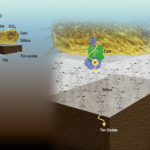Markita Landry, a faculty affiliate of the Molecular Biophysics and Integrated Bioimaging (MBIB) Division, has received a prestigious two-year Department Of Defense Advanced Research Projects Agency (DARPA) Young Faculty Award for her work developing optical probes for neuromodulators such as dopamine. An assistant professor of chemical and biomolecular engineering at UC Berkeley, Landry conducts research at the intersection of single-molecule biophysics and nanomaterial-polymer science to develop new tools to probe and characterize complex biological systems. The DARPA project will focus on using synthetic near-infrared optical nanosensors—a new technology developed in the Landry lab—to develop a brain-computer interface driven by neurochemistry. Currently such technologies rely on electrical signals for signal acquisition, processing, and machine learning algorithms. Read a Berkeley Neuroscience news article to learn about how the award will allow her to investigate visualizing the probes in awake and behaving animals.
Eva Nogales Honored by ASCB
The American Society for Cell Biology (ASCB) has selected Eva Nogales, a senior faculty scientist in Molecular Biophysics and Integrated Bioimaging (MBIB) and a Howard Hughes Medical Institute (HHMI) investigator and professor at UC Berkeley, as this year’s recipient of the Sandra K. Masur Senior Leadership Award. The award recognizes an outstanding scientist with a record of active leadership in mentoring both women and men in scientific careers. Nogales will be honored at the ASCB Annual Meeting in December 2018. Nogales was also elected by ASCB members to serve on the society’s executive committee as president-elect in 2019, president in 2020, and past president in 2021.
Ultrathin Membrane Both Isolates and Couples Living and Non-Living Catalysts
Biosciences researchers have developed a novel nanoscale membrane embedded with molecular wires that simultaneously chemically isolates, yet electrochemically couples, a microbial and an inorganic catalyst on the shortest possible length scale. This new modular architecture, described in a paper recently published in Nature Communications, opens up a large design space for building scalable biohybrid electrochemical systems for a variety of applications.
Karen Davies Receives DOE Early Career Research Award
Karen Davies, a staff scientist in the Molecular Biophysics and Integrated Bioimaging (MBIB) Division, is one of six Berkeley Lab scientists selected by the U.S. Department of Energy’s Office of Science to receive significant funding through its Early Career Research Program. The scientists are each expected to receive grants of up to $2.5 million over five years to cover year-round salary plus research expenses. Davies’ focus is on protein structure and bioenergetics, which includes the study of the flow of energy in living organisms. Her award is for “Structure of the Cyanobacterial NAD(P)H Dehydrogenase Complex (NDH-1) and Its Role in Cyclic Electron Flow and Carbon Dioxide Hydration,” selected by the Office of Basic Energy Sciences.
Cynthia McMurray Quoted in Nature Outlook on Huntington’s Disease
Biosciences’ Cynthia McMurray was recently quoted in a Nature Outlook article on the gaps in our understanding of the biology that underlies Huntington’s disease. In the piece, McMurray, a senior scientist in Molecular Biophysics and Integrated Bioimaging (MBIB), discusses possible mechanisms that give rise to the abnormal expansion of the DNA sequence cytosine, adenine, and guanine (CAG), potential functions of the huntingtin protein in cells, and the theory that chains of glutamine (encoded by CAG) make huntingtin extra sticky.
View the article as a PDF.
- « Previous Page
- 1
- …
- 41
- 42
- 43
- 44
- 45
- …
- 78
- Next Page »
Was this page useful?








